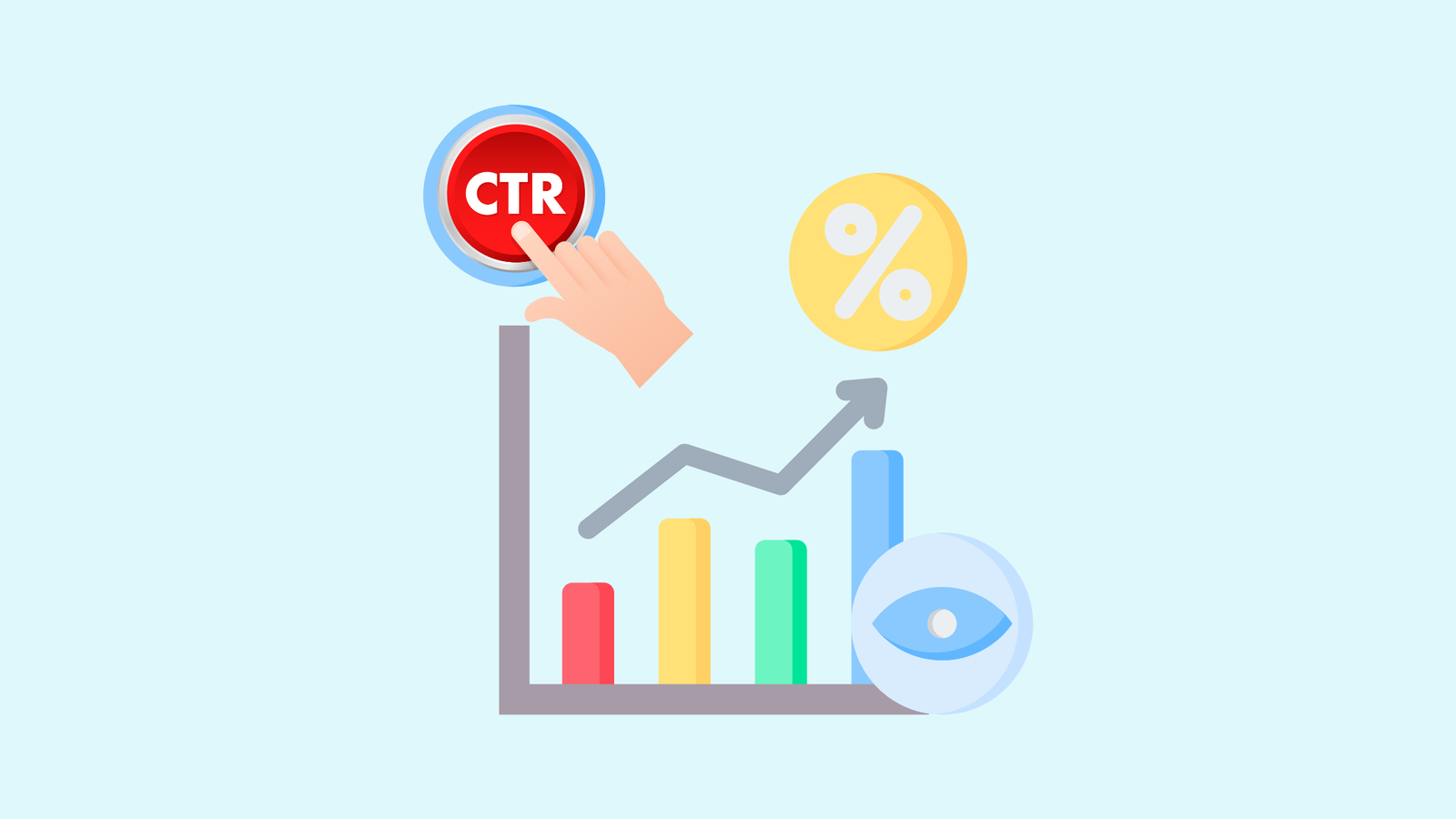Google CTR Stats Analysis: Decoding Organic Clicks
Table of Contents
You’ve put up splendid content as a blog or landing page, indexed it successfully on Google, and now waiting for a peaked organic traffic. And it all begins with just a click.
While the Google algorithm prioritizes several aspects to position thousands of millions of results on search result pages, it is necessary to know how many clicks your content is getting – and also, on what type of content (image, infographic, questions, or any other element).
In this post, we will talk about certain stats that will help in understanding the working of organic CTR on different ranking positions.
Moreover, these stats focus on evaluating the chances of improving CTR across different scenarios – conclusively helping businesses to achieve better outcomes.
What is Organic CTR?
Organic click-through rate (CTR) is a key metric that reflects the effectiveness of your website’s SEO efforts. It represents the percentage of users who view your webpage in search engine results pages (SERPs) and ultimately choose to click on it.
To calculate organic CTR simply divide clicks by impressions (views). This calculation provides valuable insights into the performance of your website for specific keywords.
While ranking well in search results is crucial for website visibility, organic CTR sheds light on how compelling your search result snippets are in enticing users to click. Analyzing organic CTR across different ranking positions allows you to assess the value of each position for driving traffic to your site.
Studies suggest a potential correlation between higher-than-average CTR and improved search engine rankings. Additionally, Google has hinted at the possible use of CTR as a factor within their ranking algorithms.
This underscores the importance of crafting compelling titles and meta descriptions that encourage users to click through to your website.
Based on the analysis of different ranking positions on Google, we have covered certain statistics on average Google CTR of every result.
We have categorized the stats according to these positions so that you can understand how CTR works.
Average Google CTR for Top Ranked Pages (#1 to #4)
The most significant observation is the overwhelming dominance of the #1 ranked page in terms of organic CTR. The analysis indicates that the #1 result captures a CTR of 27.6%, significantly higher compared to results on subsequent pages.
This highlights the substantial value proposition of achieving the top-ranking position in search results.
In addition, only 0.63% of users click on results displayed on the second page of search results. This emphasizes the critical importance of optimizing content for not only relevance but also for search engine ranking algorithms, ensuring your website appears on the first page of SERPs.
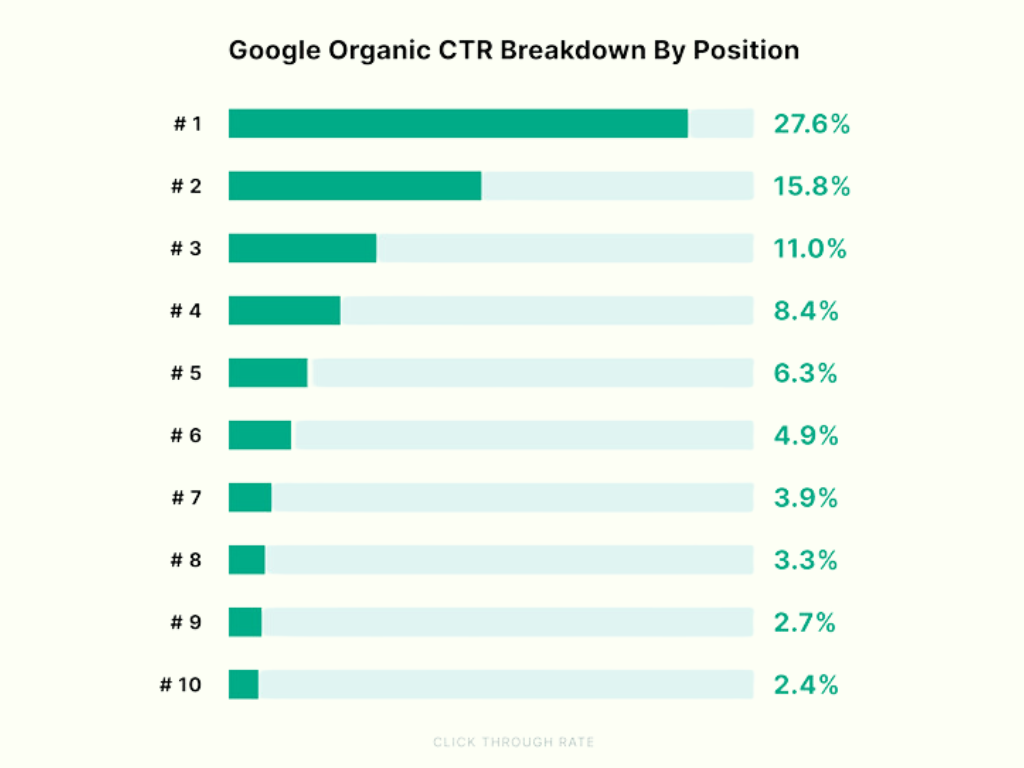
It’s important to note that CTR for the #1 result can be significantly influenced by the nature of the search query.
Branded search terms, where users are likely conducting navigational searches to access a specific website, typically generate higher CTRs for the top-ranked result compared to non-branded search terms.
Google CTR Boost on Bottom Ranked Pages (#8 & #9)
While our previous analysis confirmed the dominance of the #1 ranked page in terms of organic CTR, there are still opportunities to attract clicks even from lower positions on the first page of search results (SERPs).
Interestingly, the data reveals a notable increase in CTR specifically for the #8 position, despite a general plateau at the very bottom of the first page (#9 and #10).
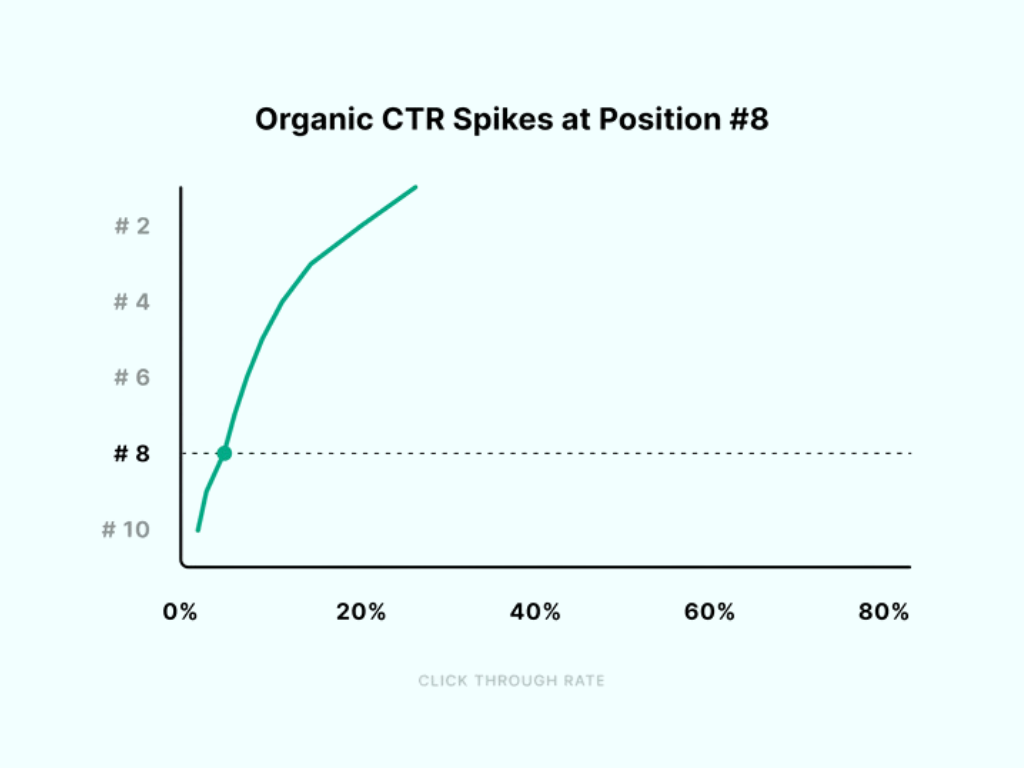
This suggests two key insights:
- User Attention on SERPs: A significant portion of users might not scroll down to view results at the absolute bottom of the search results page.
- Value of Moving Up a Rank: A jump from position #9 to #8 can lead to a significant improvement in CTR, highlighting the importance of even minor ranking improvements.
Another factor influencing CTR is the presence of search result features like ads or knowledge panels. In scenarios where these features are absent, the #2 position often appears “above the fold,” potentially leading to a secondary CTR increase for this position.
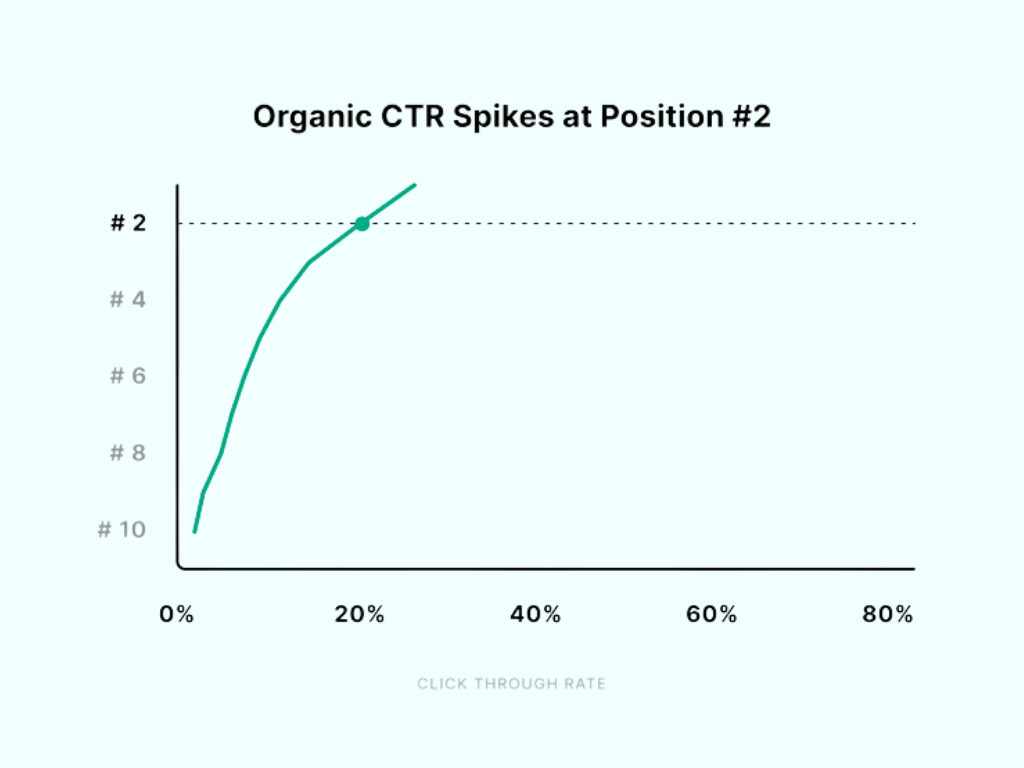
The analysis underscores the importance of striving for top rankings in search results. Our findings demonstrate that the top 3 positions collectively capture over 54.4% of all clicks. However, aiming solely for “first page ranking” might not be the most strategic SEO goal.
Impact on Google CTR on Moving Up in Rankings
While moving up even one position in search rankings can generate a positive impact on click-through rates, the magnitude of this effect varies significantly depending on the specific positions involved.
Moving up a single position in search results translates to a relative CTR increase of 32.3%. It’s important to note, however, that this boost is not evenly distributed across all ranking positions.
Climbing from the #10 to #9 spot results in a more modest 11% increase in CTR. Conversely, the jump from #2 to the coveted #1 position is associated with a dramatic 74.5% relative CTR surge. This highlights the immense value proposition of securing the top ranking for a given search term.

Overall, moving up one position translates to an average absolute CTR gain of 2.8%. However, as with relative CTR, the magnitude of this increase varies depending on the specific positions involved.
The significant CTR boost observed when moving from #2 to #1 underscores the importance of optimizing content to achieve top rankings in search results.
Clicks per Query for Ranked Websites
While a website might rank for a large number of keywords (X), 90.3% of these keywords generate very few impressions, less than 10.
This suggests two possibilities:
- Long-Tail Focus: The website might primarily rank for long-tail keywords with inherently low search volume.
- Low Ranking Impact: The website might not be achieving high enough rankings for these keywords to generate significant impressions.
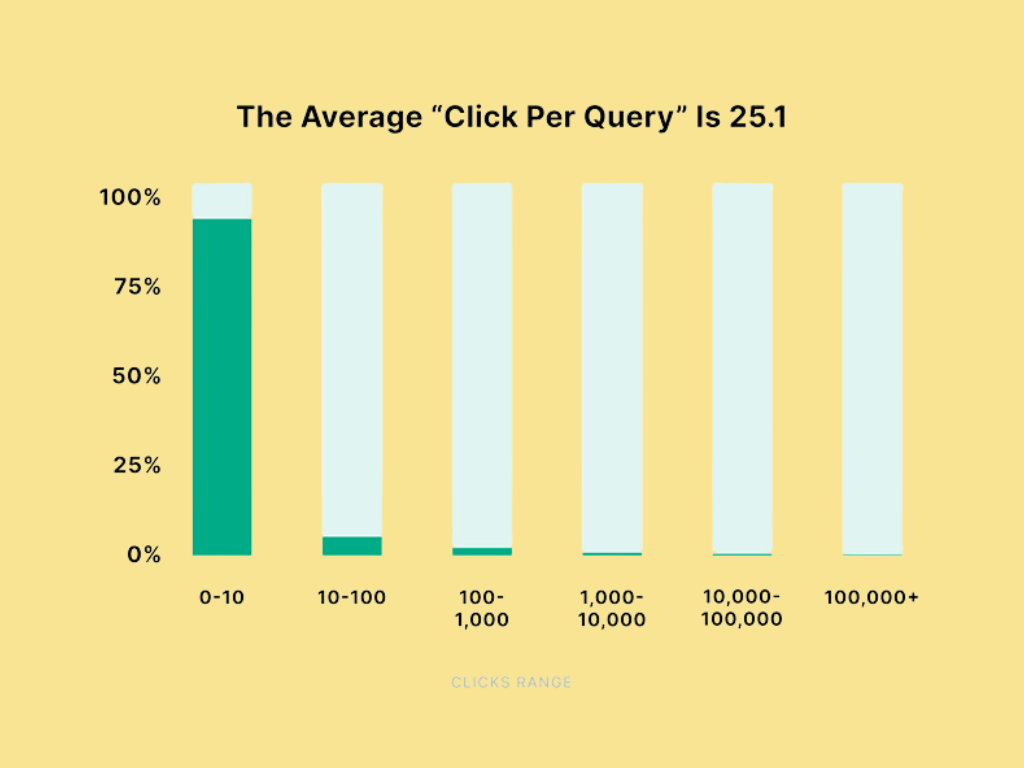
This low impression rate translates to an average of 25.1 clicks per quarter. Consequently, simply focusing on “ranking for X keywords” might not be the most effective SEO metric.
Prioritizing high-impact queries that generate a substantial number of impressions is crucial for maximizing website traffic. While ranking for a smaller number of these high-volume keywords might seem less impressive on the surface, the potential click traffic is significantly greater.
Impact on Google CTR from Question/Non-question Titles
A common debate in SEO circles revolves around the effectiveness of question-based titles for improving click-through rates (CTR). This analysis investigates the organic CTR performance of titles containing question words (“How,” “Why,” “What,” “Who”) or question marks compared to titles without them.
The data suggests a minimal difference in CTR between question-based titles (15.5%) and non-question titles (16.3%). While some studies have indicated a potential CTR boost for question titles, our findings do not support this notion with statistical significance.
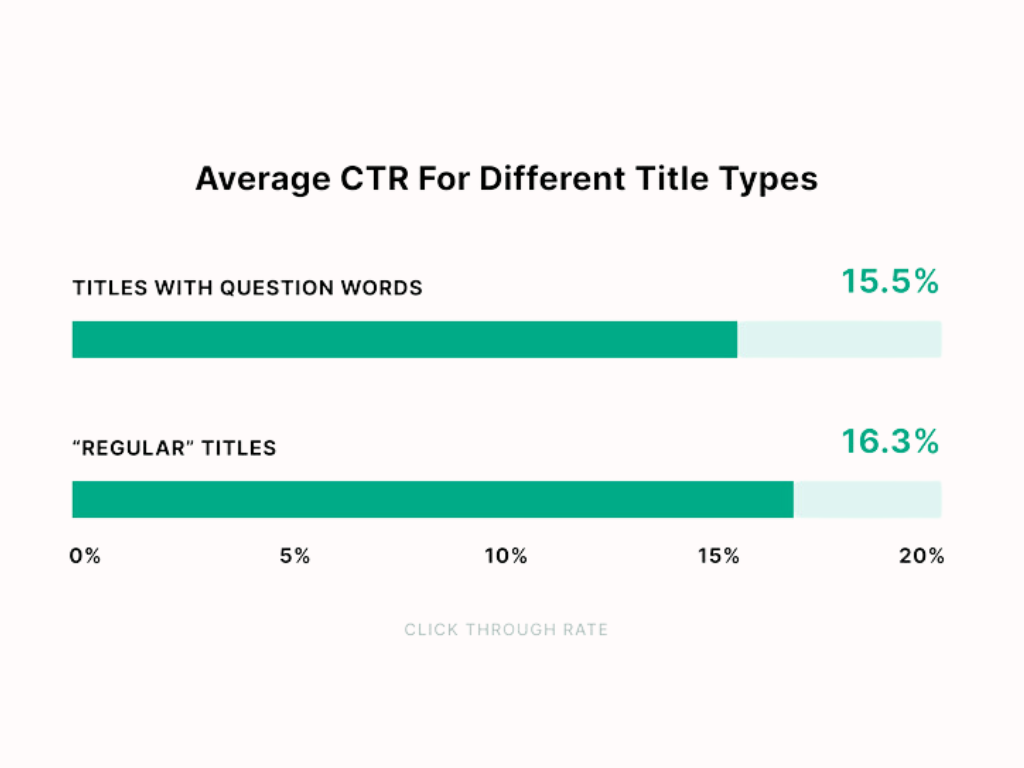
Since many searches are essentially questions seeking answers, question titles might appear more relevant to users. However, the data suggests that users might not rely solely on the presence of a question mark or question words to identify relevant content.
While question-based titles might not be a guaranteed CTR booster, crafting clear, concise, and informative titles remains crucial. Titles should accurately reflect the content of your webpage and communicate its value proposition to users.
Impact on Google CTR from Title Tags Length
According to the analysis of our SEO experts, a preference for titles within the 40 to 60 characters range in terms of organic CTR. Titles falling within this spectrum achieved the highest click-through rates. This finding held when examining title tag word count as well.
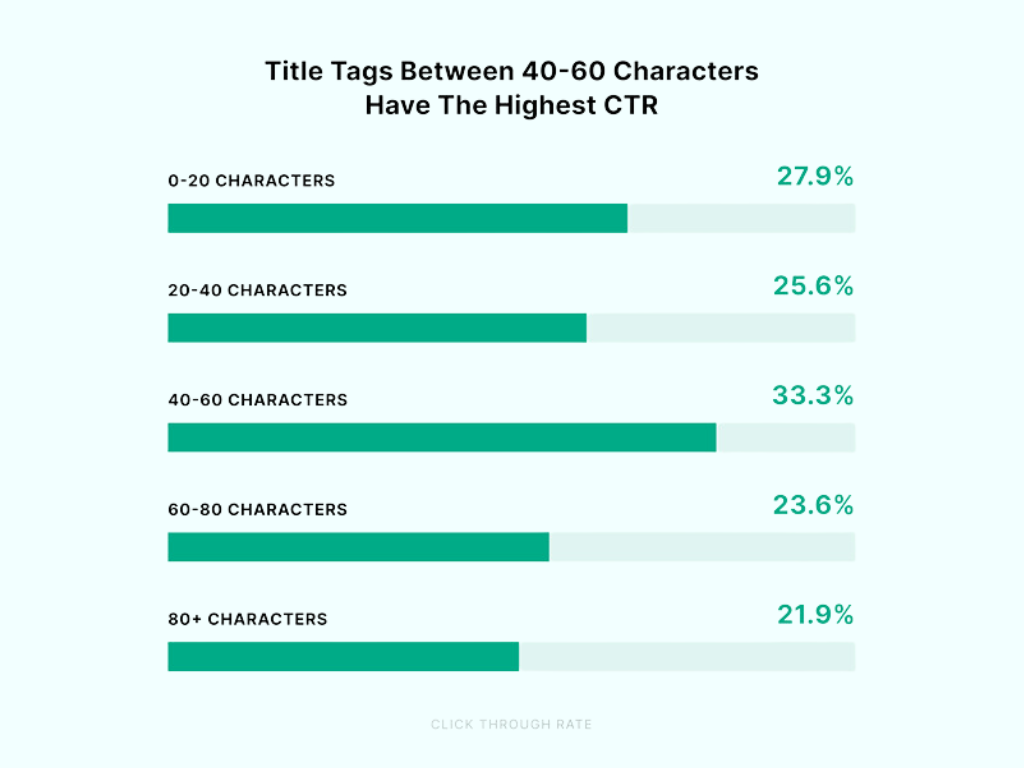
Users scanning search results pages are likely drawn to titles that are concise and informative, allowing them to quickly grasp the content’s relevance.
The data underscores the importance of finding a balance between keyword comprehensiveness and user-friendliness. Titles within this range boast an average CTR improvement of 8.9% compared to those exceeding or falling short of this recommended length.
Impact on Google CTR from Long-tail Keywords
Our analysis investigated the relationship between keyword length and organic click-through rate (CTR), specifically focusing on results ranking in the #1 position.
The data reveals a clear correlation between longer keywords and higher organic CTR. Keywords containing 10-15 words garnered 2.62 times more clicks compared to single-word terms.
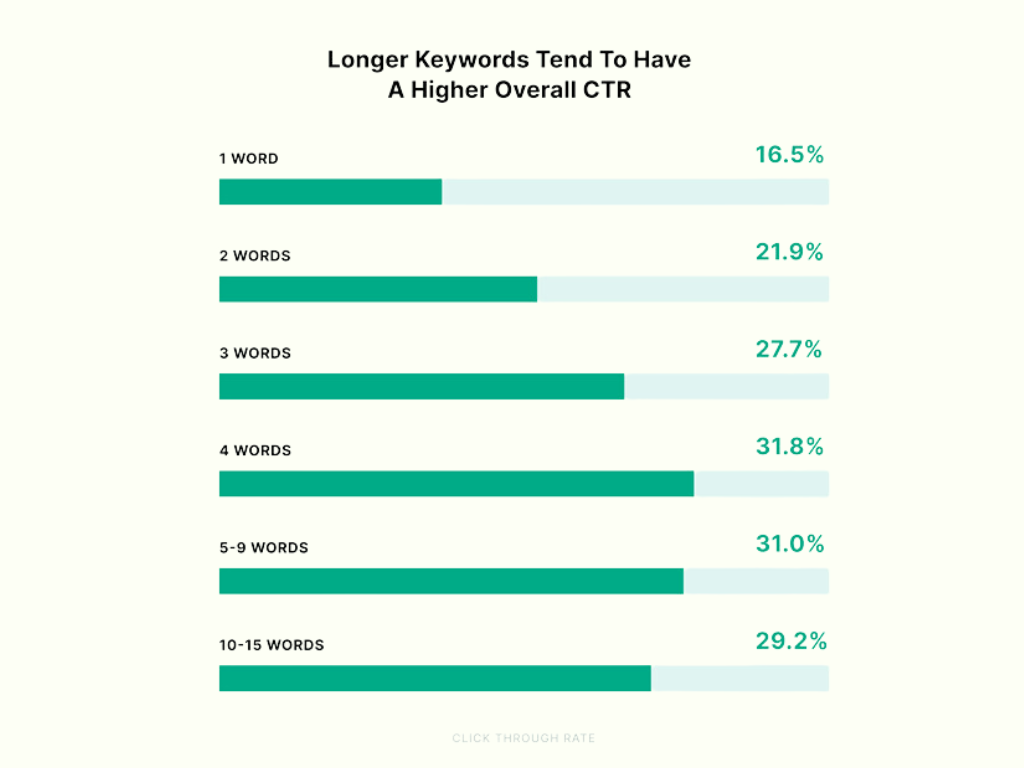
Longer keywords typically convey a more precise search intent. Users employing these keywords likely have a clearer understanding of their information needs, translating to a higher likelihood of clicking on a relevant result.
For long-tail searches, Google is better equipped to identify user intent and serve up highly relevant results at the top of the search engine results page (SERP). This increases the probability that users will find the information they seek within the top result, leading to a higher CTR.
Hence, there are 1.76x more organic clicks for long-tail keywords as compared to short keywords.
Impact on Google CTR from Keyword-rich URLs
To assess the relationship, we compared search queries with corresponding URLs. A similarity index was assigned, ranging from 0% (no resemblance) to 100% (perfect match). Punctuation and symbols were disregarded during this analysis.
It’s noteworthy that only 6.3% of URLs within the sample set exhibited a similarity index exceeding 80%. This suggests that URLs are just one factor influencing CTR among a broader landscape of ranking criteria.

While URLs with a perfect keyword match achieved the highest CTR, the data also demonstrates a positive CTR boost for URLs containing partial keyword matches from the search query. The underlying theory suggests that users leverage page URLs to gauge a webpage’s relevance to their search intent.
Consequently, URLs that perfectly or partially reflect the search query (through keyword inclusion) experience a significant CTR increase compared to URLs lacking any keyword alignment.
Tips to Enhance Google CTR
Based on the statistics, we have created a list of comprehensive tips to manage your organic CTR as required to top the rankings. Have a look:
- Quality Content Creation
Focus on crafting high-quality content that informs, engages, and inspires your target audience. Move beyond generic content; strive for authenticity and value. Search engine optimization (SEO) best practices should be incorporated to ensure your content is discoverable.
- Prioritize User Experience (UX)
Design your website with user experience (UX) in mind. This encompasses functionality, accessibility, branding, usability, and fostering faster interactions with users. A well-designed website creates a positive user experience, keeping visitors engaged and more likely to click through.
- Optimize Load Time
Leverage tools like Google PageSpeed Insights to evaluate and improve your website’s loading speed. Aim for a load time between 0-4 seconds for optimal conversion rates. Faster loading times enhance user experience and reduce bounce rates.
- Understanding User Intent
Understanding your target audience and their search intent is crucial. Identify the “why” behind user searches. By tailoring content and targeting appropriate keywords that align with user intent, you can significantly improve your website’s CTR.
- Search Volume and Popularity
Consider the search volume and popularity of keywords when crafting your SEO strategy. Target keywords that are relevant to your audience and have a decent search volume to attract qualified traffic.
- Mobile-First Approach
With over 50% of searches originating from mobile devices in the US, a mobile-responsive website is no longer optional. Ensure your website offers a seamless user experience on all devices, particularly smartphones.
- Algorithm Updates
The search engine landscape is constantly evolving. Stay informed about industry trends and Google algorithm updates. Regularly update your website to comply with these changes to maintain search engine friendliness and crawlability.
By implementing these SEO best practices and focusing on the factors that influence CTR, you can effectively optimize your website to attract more qualified clicks and achieve your overall SEO goals.
Improve Your Website’s CTR Through Our SEO Expertise
From the dominance of top-ranked positions to the power of long-tail keywords and user-friendly titles, understanding these elements is critical for crafting a winning SEO strategy.
However, navigating the ever-changing SEO landscape and implementing these strategies effectively can be a complex endeavor.
This is where eSearch Logix, a leading SEO company, can become your trusted partner.
At eSearch Logix, we possess a deep understanding of search engine algorithms and user behavior. We leverage this expertise to develop and execute comprehensive SEO strategies that are tailored to your unique business goals.
By partnering with eSearch Logix, you gain access to a team of SEO professionals dedicated to propelling your website to the top of search engine results pages and attracting a steady stream of qualified organic traffic.

